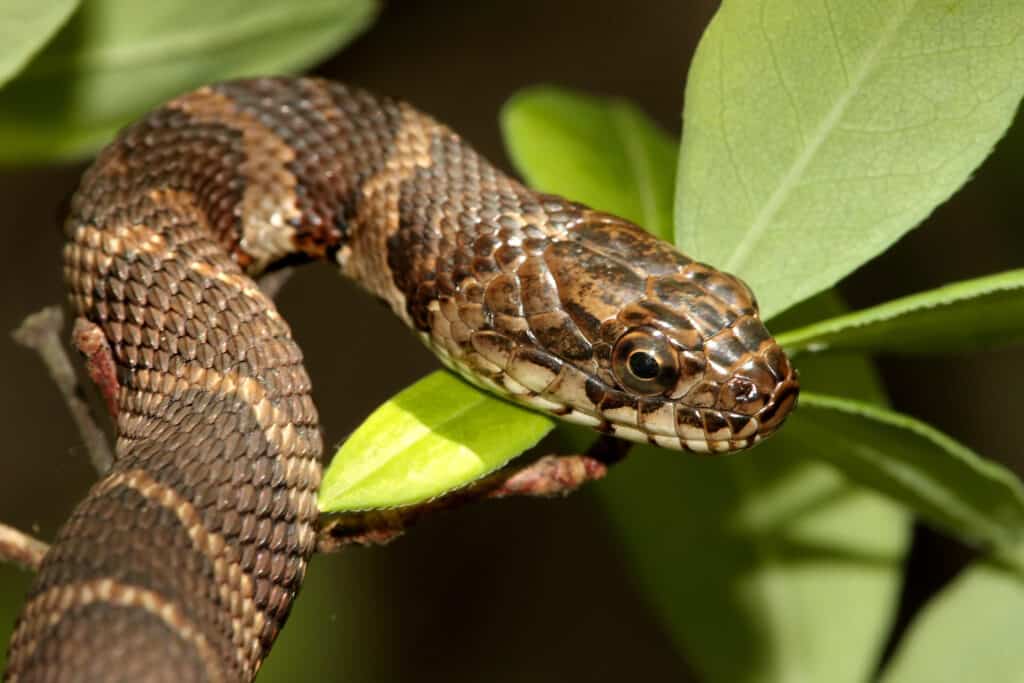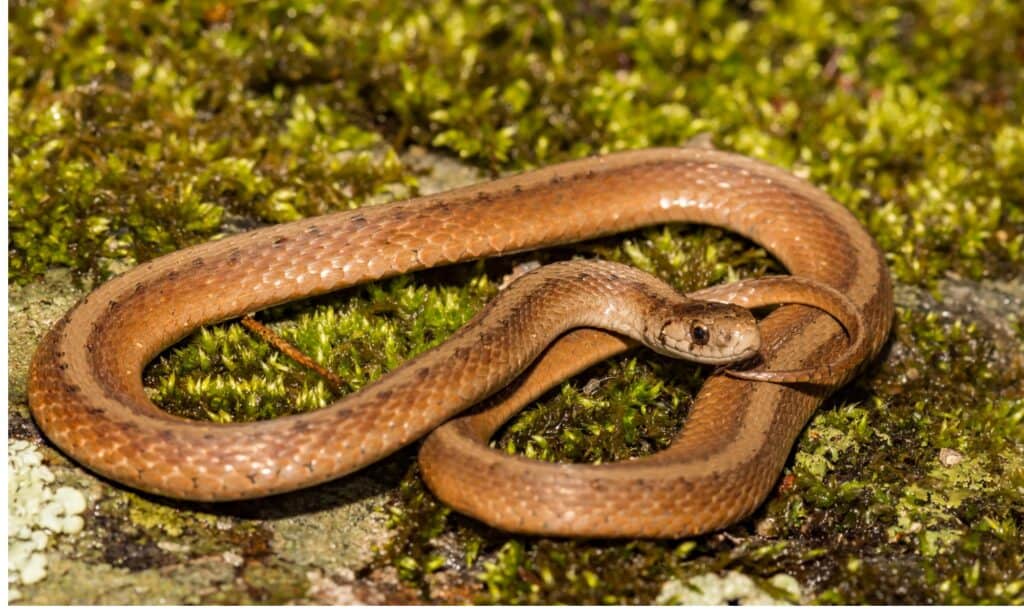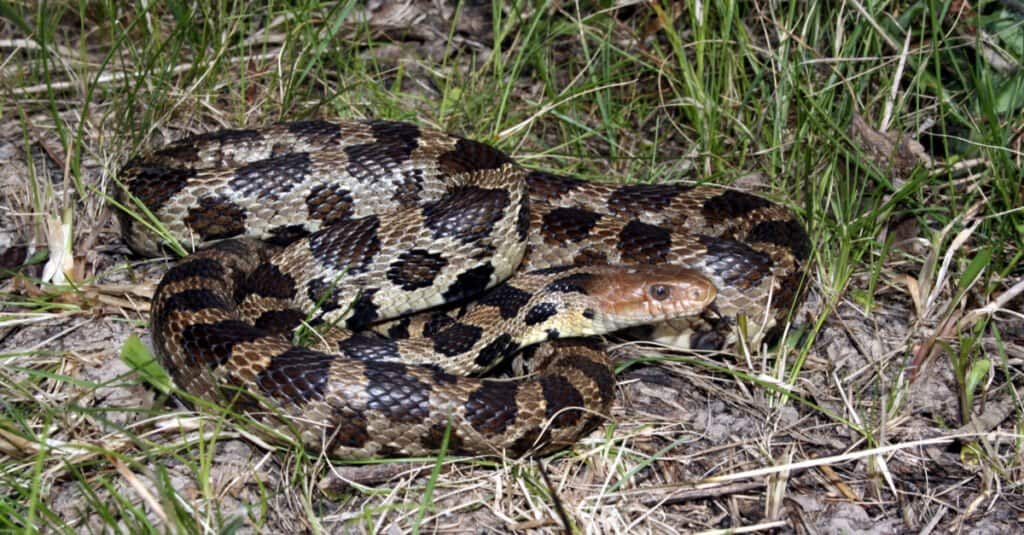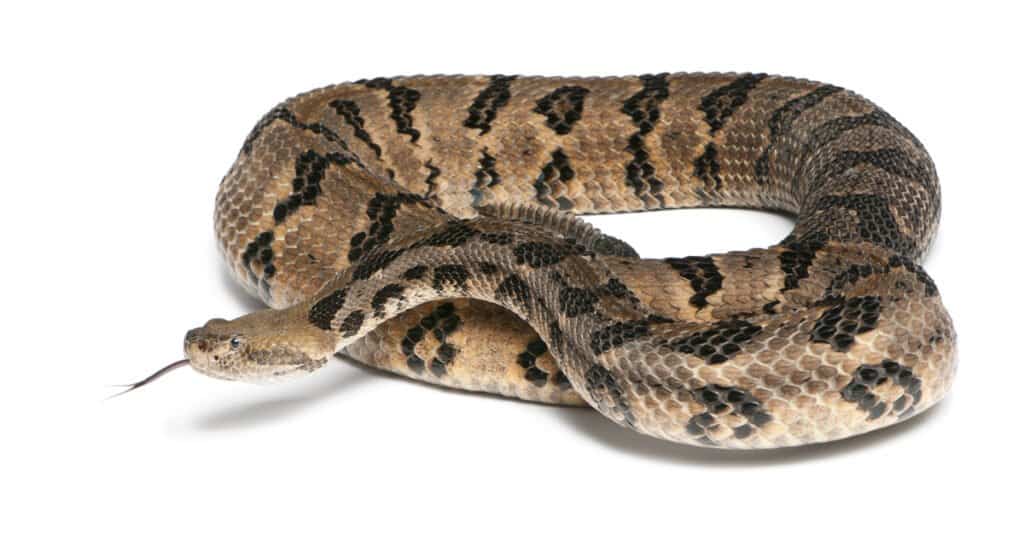Figuring out which snake you’ve spotted in your garden isn’t always easy. It’s even more difficult if snakes frighten you. However, of the over 4,000 snake species, only about 600 have venom dangerous to people and pets.
The Hawkeye state may get its nickname from its rich Native American history, but it also has a rich natural history full of beautiful animals, including snakes. As a result, Iowa’s list of legless rodent assassins is full of variety — if you’re into that sort of thing. If not, well, at least you’ll know which ones can do some damage and which snakes are just stinkers.
We turned to iNaturalist.org to find the most common snakes you’ll find in your Iowa garden.
#1 Most Common Snake in Iowa Gardens: Common Garter Snake (Thamnophis sirtalis ssp.)

All garter snakes have keeled scales, which means they have a ridge down the center.
©iStock.com/Wildnerdpix
One of Iowa’s nearly 30 snake species will likely poop on you as a defense mechanism.
Garter snakes of all kinds do this. In fact, the moment you decided to pick up a garter snake is coincidentally the exact moment it decided to release the stench. Then, it’ll work hard to spread it on you during its escape.
In fairness, many snakes use what scientists call “musk” as a predator-deterrent, but garter snakes think it’s the first line of defense instead of the last.
The common garter snake has over a dozen subspecies that aren’t always easy to distinguish from one another. Most differences relate to location or coloration, but a few have bigger eyes than average or some other identifying factor that makes it easier.
In Iowa gardens, the most common subspecies are the red-sided and the eastern garter snakes. Common garter snakes are common across Iowa, but which subspecies you find depends on your location. For example, the eastern garter snake is more common in the eastern half of Iowa, while the red-sided garter snake is more common in the west.
Regardless, garter snakes have three yellow or cream-colored longitudinal stripes that begin behind the head and run the length of their bodies. One stripe runs down the center of their backs, with one stripe on each side of their bodies. Common garter snakes’ base color varies between brown, gray, and black. The red-sided garter snake has additional red markings between its stripes.
These snakes prefer a wetter habitat, so you’ll often see them near a water source or in wet leaf litter.
Common garter snakes average 18 to 48 inches long have round pupils and vertical bars along their lower lips. They eat anything they can overpower with their jaws (not constrictors!), which usually includes slugs, snails, worms, frogs, mice, and bird eggs.
Northern water snake (Nerodia sipedon)

Common watersnakes have the widest range of any U.S. water snake.
©Steve Byland/Shutterstock.com
Northern water snakes are semi-aquatic and spend much of their time in or near the water. Do you have fish swimming around in your pond? Maybe not for long!
Also called the common water snake, the northern water snake has a broader range than any other species. It can reach four and a half feet long and has some pretty wicked teeth – perfect for grabbing fish and frogs! But, unfortunately, it’s also happy to use those teeth on anyone brave enough to pick one up.
They’re shy snakes that would rather avoid you. And, with their coloration, they don’t have to try very hard.
Common watersnakes are brown to light brown or gray with reddish-brown crossbands. It perfectly camouflages them among the pond plants. As the snakes age, they become darker, eventually losing most of their juvenile pattern. In areas where cottonmouths also live, watersnakes are often mistaken for them.
Unlike the venomous snakes that people sometimes confuse them with, water snakes have round pupils and vertical bars along their lips. The bars, called labial bars, are a trait that nonvenomous snakes in North America often share — and help you determine whether that snake in your Iowa garden is dangerous.
Common water snakes have keeled scales, meaning their scales have a ridge that marks the halfway point in the scale. Keeled scales make snakes (and lizards) look rough, like sandpaper. They’re common across the eastern half of the U.S., except Florida.
Dekay’s brown snake (Storeria dekayi)

Northern brown snakes are the type species for Storeria dekayi
©iStock.com/JasonOndreicka
If you’ve ever found a small brown snake under a rock, it might have been a Dekay’s brown snake. They’re common in gardens across the eastern half of the U.S. but are so innocuous that you’ll seldom see them.
These nonvenomous garden snakes eat slugs, snails, and earthworms. While we love having earthworms in our garden soil, snakes like Dekay’s brown snake keep them from overrunning our gardens.
Most Dekay’s brown snakes are about 12 inches long, but the record was just a hair over 19 inches. They have a brown to gray base color with a lighter dorsal stripe. Some individuals have a checkered pattern on either side of their dorsal stripe, while others are solid brown.
They have round pupils and keeled scales. These extremely docile snakes rarely bite, but they’re so small that you probably wouldn’t even feel it. Dekay’s brown snakes love hiding under rotted wood, logs, and rocks where their favorite prey hides. They’re harmless garden helpers — a sign of a healthy garden ecosystem.
Western fox snake (Pantherophis ramspotti)

The only real difference between the two fox snake species is that the western tends to have more grey in the base color.
©Psychotic Nature/Shutterstock.com
In the same genus as eastern rat snakes (Pantherophis alleghaniensis), nonvenomous western fox snakes are their marsh-dwelling cousins. However, where rat snakes don’t care which humans they upset, western fox snakes are shyer and more likely to avoid you.
Western fox snakes are terrific climbers but are more often found on the ground. They eat anything small enough to fit in their mouths — rats, mice, ground-nesting birds, lizards, etc.
People often confuse adult western fox snakes for copperheads because of their head color — their reddish-brown heads can look similar to that of a copperhead. However, where a copperhead’s head is broad and triangular, western fox snakes have a narrow head.
Their base color is gray to light brown with dark brown to black blotches. Fox snakes and other rat snake species have similar body patterns. However, western fox snakes have jagged edges on their markings and keep their pattern throughout their lives.
These snakes average two to four feet long but can reach six feet. They’re common throughout most of Iowa; although they can hang out in your city garden, they’re more likely to be in a rural area. So, if you live out in the country with grasslands, forests, and the marshy regions of Iowa, finding a western fox snake in your garden is pretty likely.
Plains garter snake (Thamnophis radix)

Plains garter snakes have a bright orange or yellow dorsal stripe that starts right behind the head.
©Alyssa Metro/Shutterstock.com
Another garter snake. They’re one of the most common snake groups in North America. The plains garter snake ranges from southern Canada to northern Texas and might hybridize with common garter snakes (Thamnophis sirtalis).
Plains garter snakes average about three feet long and prefer living near a water source. However, this snake is common in Iowa gardens, vacant lots, and debris piles.
As garter snakes go, this species is relatively easily identified. They have an orange or yellow dorsal stripe and an additional yellow stripe on each flank. Plains garter snakes also have distinctive vertical black bars on their lips. Between the stripes, they’re often black or very dark greenish brown.
Harmless to humans, plains garter snakes have a very mild venom that they use to disable their prey. Their preferred prey includes earthworms, slugs, amphibians, and the occasional small bird.
Like other garter snakes, the plains garter snake will musk you at the first sign of the most harmless touch. You’ll be washing your hands after you handle one.
Other Iowa Garden Snakes
Our top five snakes not-withstanding, Iowa has quite a few species — some of which might find their way into your garden.
Here are the most likely:
- Black rat snake (Pantherophis obsoletus)
- Smooth earth snake (Virginia valeriae)
- Prairie ring-neck snake (Diadophis punctatus arnyi)
- Bullsnake (Pituophis catenifer sayi)
- Racer (Coluber constrictor)
- Western worm snake (Carphophis vermis)
Venomous Snakes in Iowa Gardens
Iowa’s five venomous snake species don’t even make the top 10 for most common snakes in the Hawkeye state. Seriously. The closest one comes is the timber rattlesnake at number 11, but this snake is either threatened or endangered throughout most of its native range.
Fortunately, knowing whether a snake in your Iowa garden is venomous is pretty easy. They are all pit vipers, which means they share one very distinctive feature: a heat-sensing pit between their nostril and eye. It looks almost like an extra nostril, but it’s so much more.
Pit vipers’ loreal pits (heat sensing organs) are so accurate that the know whether they’re striking a lizard or a mammal. Loreal pits give this group of snakes a decided night-vision advantage over other nocturnal snakes.
The other distinguishing factor that most pit vipers share is a large-for-its-body head with a thinnish neck. Their heads house the rather large venom glands and retractable, hypodermic needle-style teeth.
Remember that many snake species can flatten their heads to appear bigger. It’s a defense mechanism, so you have look for additional traits — vertical pupils, tail rattles, dark bands behind the eyes, etc.
Timber rattlesnake (Crotalus horridus)

Timber Rattlesnakes are shy and don’t want to bite — they’d prefer if you just left them alone.
©Eric Isselee/Shutterstock.com
The rattlesnake with the horrible specific name…yes, the horridus part of their name means horrible or terrible. However, timber rattlesnakes are super shy and do not want to bite. They’re not aggressive and freeze when someone walks nearby, which is actually why people get bitten.
Most rattlesnake species are ambush predators, meaning that they find a good hiding spot and wait. They sometimes wait for days for prey to wander close enough to strike.
A timber rattlesnake’s first line of defense is its camouflage. So, if you or your dog wander by, it’s not likely to move. You’re better off going around if at all possible, because it’s literally frozen in fear. However, if you step on it, you’ll get bitten.
Speaking of camouflage, their pattern is excellent for hiding! They have a gray to yellowish-brown base color with v or m-shaped cross bands. Many individuals also have a yellowish dorsal stripe between the cross bands. Melanism is common in timber rattlesnakes, and becomes more common the further north they live. If you see a nearly black rattlesnake, it may be a timber rattlesnake.
Timber rattlesnakes have a large, spade-shaped head with black stripes that start from the back of their eye. They have vertical pupils and look a little cranky because they have an extra ridge of scales over their eyes. These snakes can reach six feet long, but tend to be shorter.
Timber rattlesnakes like forested areas with lots of leaf litter, fallen logs, and rock outcrops where they can hide and find prey. If you see a timber rattlesnake, it’s not likely to be in your Iowa garden unless you live on several forested acres. However, the species occurs in south and east Iowa.
Other Venomous Snakes in Iowa
- Copperhead (Agkistrodon contortrix)
- Eastern massasauga (Sistrurus catenatus)
- Prairie rattlesnake (Crotalus viridis)
- Western massasauga (Sistrurus tergeminus)
Keeping Snakes Out of Your Garden
If you’d prefer to not have any of these legless garden helpers around, your best bet is to clear out any hiding areas for the snakes or their prey.
Remember — snakes follow the food and seek shelter.
Those blogs that say you can repel snakes with this or that plant aren’t correct. If those plants repel anything, it’s the snake’s prey.
Here’s what you need to look for when trying to minimize snakes in your yard:
- Debris and wood piles are really common hiding places.
- Openings where either can get into or under your house.
- Dense leaf litter can harbor snakes.
The photo featured at the top of this post is © Alyssa Metro/Shutterstock.com
Discover the "Monster" Snake 5X Bigger than an Anaconda
Every day A-Z Animals sends out some of the most incredible facts in the world from our free newsletter. Want to discover the 10 most beautiful snakes in the world, a "snake island" where you're never more than 3 feet from danger, or a "monster" snake 5X larger than an anaconda? Then sign up right now and you'll start receiving our daily newsletter absolutely free.
Thank you for reading! Have some feedback for us? Contact the AZ Animals editorial team.







